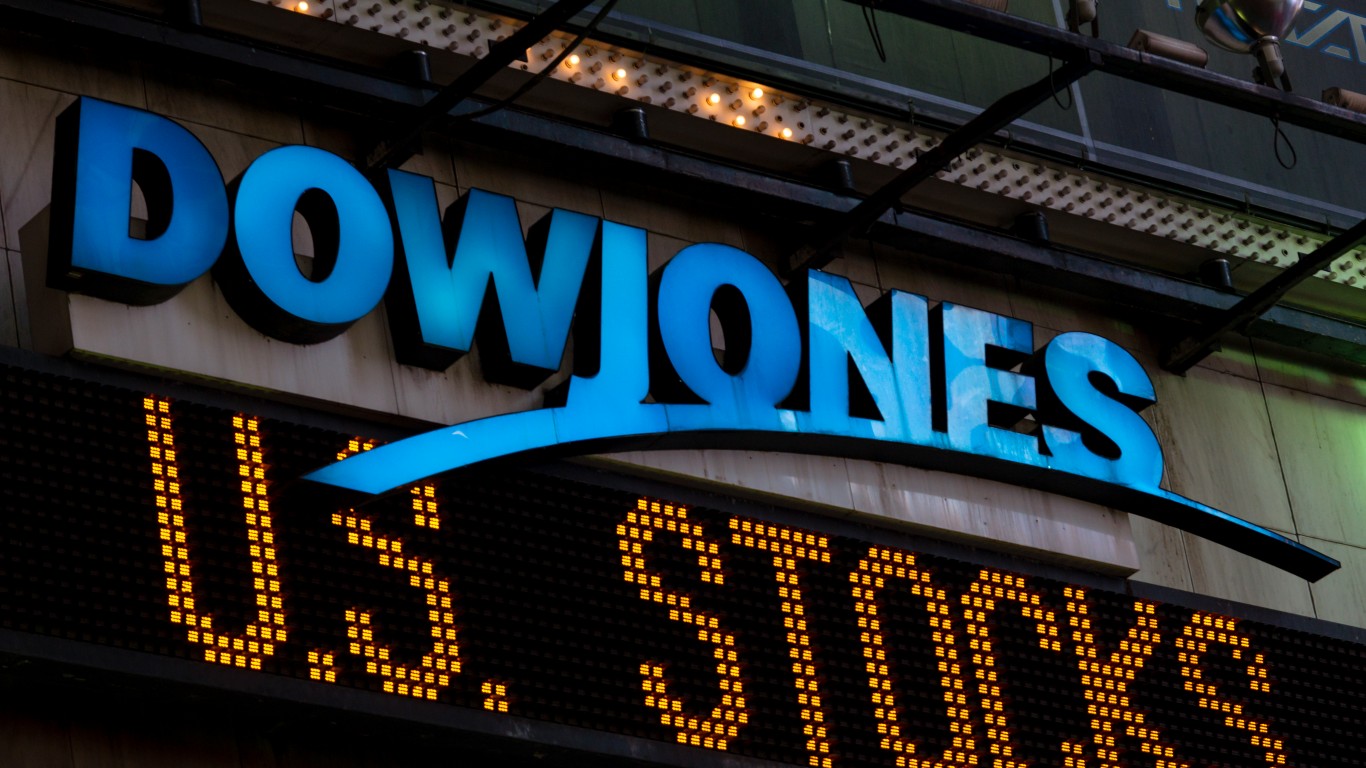
24/7 Wall Street Insights
- Exchange Traded Funds offer a stock market type platform to invest in various indexes
- REIT ETFs are available from a number of issuers.
- For investors seeking dividends, click here for a free report on two high dividend stocks.
Many people face an investment dilemma. Seeing the gains made in the stock market since 2016 has been daunting over concerns of missing out. There are those who are unsure as to which stock still can run higher. Not every stock can be a Microsoft (NASDAQ: MSFT). A number of people believe that the market is a bubble about to burst. The overall gains of the Dow Jones Industrial Average and S&P 500 over the past decade would have been more than satisfactory for a great majority. Mutual Funds offer diversification and a way to invest in an index on a prorated basis. Exchange Traded Funds (ETF) also offer these features, with some differences.
ETFs vs. Mutual Funds – A Comparison

Exchange Traded Funds and Mutual Funds have a number of likenesses. Here are the primary ones:
- Both ETFs and Mutual Funds are pools of individual stocks, bonds, derivatives contracts or other securities that represent the sector of interest.
- Both ETFs and Mutual Funds offer diversification and risk mitigation properties through a prorated interest in the total fund’s assets.
- ETFs and Closed-end Mutual Funds both have a fixed number of shares and trade on NYSE or NASDAQ at a market bid/ask price.
Their differences are starker – the following apply to Open-Ended Mutual Funds::
- Unlike where one can buy a single ETF share, Mutual Funds have minimum investment amounts.
- Given that par value for a single bond is $1,000, An ETF share that tracks bonds can be purchased for considerably less.
- Mutual Funds trade at the same NAV price for the entire day. ETFs trade at a live bid/ask market price, which can vary within seconds.
- Most ETFs are passively managed and pegged to a benchmark index. Mutual Funds are usually actively managed, which is correspondingly costlier.
- Mutual Funds have varying loads, and early redemption fees, which are factored into their costs. ETF costs can be a premium to NAV, broker commissions, and market maker bid/ask spreads.
- Mutual Funds are taxed differently (usually higher) than ETFs with regard to capital gains.
SPDR Dow Jones Industrial Average ETF Trust

ETF: SPDR Dow Jones Industrial Average ETF Trust (NYSE: DIA)
Shares for $10,000: 25.56
Yield: 1.74%
Fees: 0.16 expense ratio
Created in 1998 by State Street Global Advisors Trust Company, the SPDR Dow Jones Industrial Average ETF Trust is an ETF designed to track and mimic the value fluctuations of the Dow Jones Industrial Average. With $32.4 billion AUM, SPDR Dow Jones Industrial Average ETF Trust replicates the 30 Dow Jones Average stocks on a proportional basis within its own portfolio. Created over 100 years ago in 1896 by Wall Street Journal founders Charles Dow and Edward Jones, the Dow Jones Average 30 stock list has changed several times over the years, but is still an often referenced weather vane indicator of US industrial health.
The top 10 holdings of SPDR Dow Jones Industrial Average ETF mirrors the exact same allocation percentages as in the Dow Jones Industrial Average.
| UnitedHealth Group Incorporated | 8.16% |
| Microsoft Corporation | 7.60% |
| Goldman Sachs Group Inc. | 7.48% |
| Home Depot Inc. | 5.73% |
| Caterpillar Inc. | 5.49% |
| Amgen Inc. | 5.26% |
| Visa Inc. Class A | 4.47% |
| McDonald’s Corporation | 4.33% |
| Salesforce Inc. | 4.24% |
| American Express Company | 3.83% |
For an idea as to the accuracy of the ETF’s tracking with the Dow Jones Industrial Average, note the following:
At the end of June 2014, DIA was at 170.48 and the DJIA was at 17,069.26. At the time of this writing, DIA is at 391.14 and the DJIA is at 39,118.86. The nearly 100% gain is mirrored, proportionately, within roughly 0.04%.
iShares Core S&P 500 ETF

ETF: iShares Core S&P 500 ETF (NYSE: IVV)
Shares for $10,000: 18.27
Yield: 1.31%
Fees: 0.03% expense ratio
Created by asset management leviathan BlackRock, iShares Core S&P 500 ETF is designed to track and replicate the market movements of the S&P 500 Index. Starting in 2000, iShares Core S&P 500 ETF now has $487.9 billion AUM, and it competes with other ETFs and mutual funds that seek to also emulate the S&P 500 index.
As of the time of this writing, iShares Core S&P 500 ETF has the following top 10 positions in portfolio, which may differ slightly from its rivals:
| Microsoft (NASDAQ: MSFT): | 7.30% |
| Apple Inc. (NASDAQ: AAPL): | 6.69% |
| Nvidia Corp. (NASDAQ: NVDA): | 6.61% |
| Amazon.com (NASDAQ: AMZN): | 3.93% |
| Meta Platforms Inc. (NASDAQ: META): | 2.47% |
| Alphabet Inc. Class A (NASDAQ: GOOGL): | 2.36% |
| Alphabet Inc. Class C (NASDAQ: GOOG): | 1.98% |
| Berkshire Hathaway – B (NYSE: BRK.B): | 1.60% |
| Eli Lilly & Co. (NYSE: LLY): | 1.57% |
| Broadcom, Inc.. (NASDAQ: AVGO): | 1.50% |
A ten year total return (including dividends) investment for iShares Core S&P 500 ETF is 237.03%. The S&P 500 Index benchmark, for the sake of comparison, is 238.26%. The differential between the ETF and index is 1.23%.
REIT ETFs

Real Estate Investment Trusts (REITs) are real estate trusts that are registered with the SEC, which allow the trusts to access the capital markets as public entities. In return for tax considerations, REITs are required to remit 90% of their profits to their shareholders. They are an excellent way for investors to invest in real estate. Rent roll or mortgage payment profits are remitted on a prorated basis for a fraction of what it would cost to invest in an actual bricks and mortar property.
The REIT sector has become huge. In 1990, the REIT market was $8.7 billion. By the start of 2024, it had grown to $2 trillion, globally.
REITs come in a broad range of company types and businesses. Some variations can include:
- REITs that acquire, develop and manage commercial or multifamily residential properties in a hands-on fashion.
- REITs that originate and finance mortgages, as well as engage in other types of real-estate collateralized lending structures.
- REITs that only buy third party mortgage paper that is agency backed (i.e., Freddie Mac or Fannie Mae), as well as other types of Asset Backed Securities (ABS).
There are also some REITs that share select characteristics from the above examples but specialize in properties configured for specific industries, such as healthcare, manufacturing, or retail food marketing, to name a few.
REIT ETFs may follow the trends of certain REIF indexes or may combine various types of specialty REITs that trade publicly within their respective portfolios. Some examples of the more popular REIT ETFs are:
- Schwab US REIT ETF (NYSE: SCHH) – This is a $6.3 billion ETF that mirrors the Dow Jones Equity All REIT Capped Index.
- iShares Core US REIT ETF (NYSE: USRT) – This is a $2.4 billion ETF that reflects the FTSE Nareit Equity REITs Index.
- Invesco Active US Real Estate Fund (NYSE: PSR) – Although it’s a diminutive $60 million in assets compared to the other ones above, Invesco Active US Real Estate Fund uses AI generated quantitative analyses for its selections. The algorithms are programmed to select ETFs from the FTSE Nareit Equity REITs Index. Prior to a selection being made for the portfolio, the algorithm analyzes risk adjusted returns and income dependability.
Additionally, there are REIT ETFs that offer exposure to international REITs. Modeled after US REITs, European and Asian REITs have grown 31% and 25%, respectively, in only the past 4 years. China now has 23 publicly listed REITs and India has 5. The SPDR Dow Jones International Real Estate ETF (NYSE: RWX) offers international REIT exposure for investors so inclined. It tracks the Dow Jones Global ex-U.S. Select Real Estate Securities Index.
Depending on an investor’s risk tolerance, available monitoring time, and investable fund liquidity, ETFs offer many convenient ways to invest so as not to lose out on market moves. On the same token, ETFs come in a wide enough range with a number of competing offerings for the popular indexes or collecting dividends , so some personal due diligence is required for the best fit.
Are You Still Paying With a Debit Card?
The average American spends $17,274 on debit cards a year, and it’s a HUGE mistake. First, debit cards don’t have the same fraud protections as credit cards. Once your money is gone, it’s gone. But more importantly you can actually get something back from this spending every time you swipe.
Issuers are handing out wild bonuses right now. With some you can earn up to 5% back on every purchase. That’s like getting a 5% discount on everything you buy!
Our top pick is kind of hard to imagine. Not only does it pay up to 5% back, it also includes a $200 cash back reward in the first six months, a 0% intro APR, and…. $0 annual fee. It’s quite literally free money for any one that uses a card regularly. Click here to learn more!
Flywheel Publishing has partnered with CardRatings to provide coverage of credit card products. Flywheel Publishing and CardRatings may receive a commission from card issuers.
Thank you for reading! Have some feedback for us?
Contact the 24/7 Wall St. editorial team.





